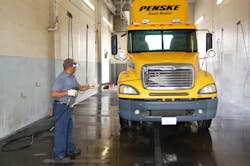Manager: Jack Mitchell
Title: Vice president-remarketing
Fleet: Penske Truck Leasing
Operation: 215,000 light, medium and heavy trucks plus trailers
Problem:
Selling used iron in the trucking business usually isn’t a problem; getting the most value for said equipment can be, however. That’s why Penske Truck Leasing established Penske Used Trucks, a separate business arm to handle selling the light-, medium- and heavy-duty trucks, trailers and related equipment coming off customer leases.
“We expect to sell about 23,000 units this year,” notes Jack Mitchell, vice president of remarketing for Penske Used Trucks.
Yet five years ago, Penske mainly disposed of its used equipment via wholesale arrangements with OEMs and dealerships—effective channels for moving used iron but not necessarily for maximizing its dollar value at sale.
“The maintenance we provide all along the way on our trucks is what makes them valuable,” Mitchell says. “We’re 100% compliant on all our preventive maintenance intervals and conduct oil analysis regularly on every truck.”
In fact, he points out that surveys of Penske’s used-truck customers indicate that maintenance history, not price, is the major reason they buy from Penske. That’s why Penske felt an opportunity existed to get more value for its used iron.
Solution:
Penske created a call center in 2009 to better focus sales efforts on its used iron. The establishment of what the company calls “out-service” maintenance care alongside a chain of physical retail sales centers in Charlotte, NC, and Torrance, CA—with two more potential locations to be added this year—is helping to amplify those efforts.
“We have a dedicated team that conducts what we call out-service, [which is] a 70-point check of a vehicle or piece of equipment prior to sale that includes a test drive and inspection,” Mitchell notes.
He likens that process to a detailed preventive maintenance, with the vehicle chassis, engine, components and even tires being checked and fixed if needed. The vehicle is pressure-washed on the outside, decals and old DOT numbers are removed, bumpers are touched up, and the complete interior is cleaned.
It’s all part of Penske’s plan to broaden the scope of its efforts to sell late-model used commercial trucks, not just through retail efforts but also via wholesale channels, used-truck dealers, and corporate truck fleet buyers. The types of equipment Penske sells run the gamut from sleeper and day cab tractors to straight trucks, flatbeds, refrigerated vans, trailers and more.
Penske is even adding three- to six-month warranty coverage to the used equipment it puts up for sale to help make it more enticing to buyers. The warranty is provided through National Truck Protection Co. Not only does all of that help Penske sell its used rolling stock at a better price, it helps the company move it at a faster pace, too. Mitchell says 75% of the buyers contacting Penske Used Trucks through its call centers buy trucks and trailers sight-unseen, largely because of the maintenance performed both over the life of the unit while at Penske and as part of the out-service program.
“The big driver for buyers is to get good usable life out of the equipment they are purchasing, and all the maintenance we do helps to achieve that,” Mitchell points out.
For example, he notes that the average total life expectancy, or B50, of a commercial tractor is 1.2 million mi. Penske typically sells off its non-sleeper tractors with 350,000 mi. and sleepers with 650,000 mi. on the odometer (straight trucks get sold off usually at the 175,000-mi. mark), so its maintenance efforts are geared to reassuring buyers they can continue to get good service from those vehicles past those B50 mileage amounts.
“To me, it’s a two-fold benefit: Not only are we getting a more retail price for our used equipment, we are not locked into any one particular channel to sell through,” he explains. “And it’s that maintenance we do over the life of the vehicle and right before we sell it that makes all the difference.”
About the Author
Sean Kilcarr
Editor in Chief
Sean Kilcarr is a former longtime FleetOwner senior editor who wrote for the publication from 2000 to 2018. He served as editor-in-chief from 2017 to 2018.
